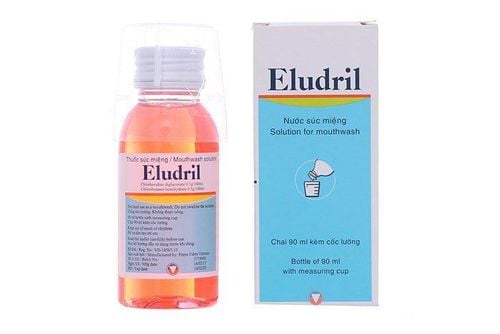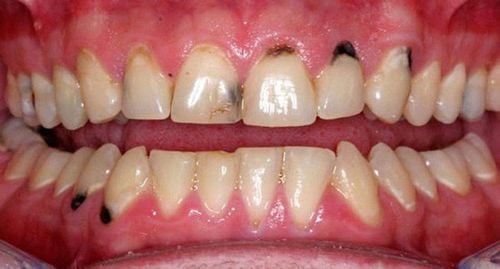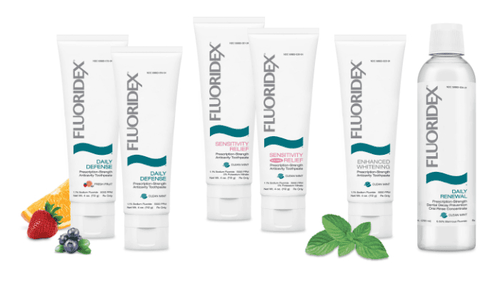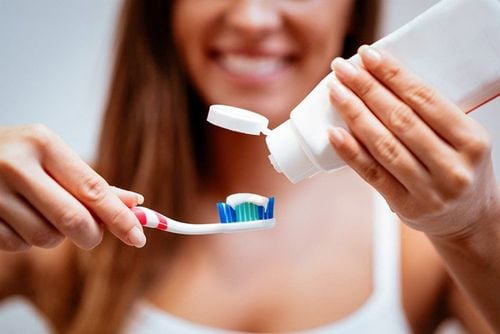This is an automatically translated article.
Besides brushing and rinsing, dentists recommend flossing to clean and dislodge food stuck between teeth, effectively reducing the amount of bacteria and plaque in the mouth. However, you need to floss correctly, because flossing incorrectly can damage teeth and gums.
1. Why use dental floss?
Plaque on teeth accumulates causing tooth decay and gum diseases. Using dental floss (thin thread used in oral hygiene) helps remove food and dental plaque between the teeth in places that a toothbrush cannot reach. The correct use of dental floss brings a number of benefits to oral health such as:
Prevention of gingivitis: the plaque in the teeth that accumulates for a long time is one of the causes of gingivitis. Proper flossing regularly can remove plaque buildup at the gum line, thus preventing gingivitis. Diabetes prevention: Bacteria that accumulate in the mouth can affect blood glucose levels. Prevention of bad breath: bacteria accumulate in the mouth causing bad breath, making you feel less confident when talking. Although, brushing and rinsing can remove bacteria, but not completely. Studies show that flossing can improve your breath after a week. Reducing the risk of respiratory diseases: when you eat or drink, bacteria that accumulate in the mouth can travel down the throat and into the respiratory tract. Flossing helps remove some oral bacteria that cause bronchitis and pneumonia. Prevent cardiovascular diseases: a consequence of plaque is gingivitis, bleeding gums. When the root of the tooth is bleeding, bacteria can simultaneously enter the bloodstream and attack the body. As a result, it leads to cardiovascular diseases or blood clots. Watch now: Mistakes when cleaning teeth with dental floss

Dùng chỉ nha khoa đúng cách giúp bảo vệ răng miệng
2. What types of floss are there?
Dental floss has many types. Depending on your preference, the distance between your teeth and whether you have braces or bridges to choose the right type of floss. Currently, there are two main types of floss:
Roll floss: it's a thin nylon thread that can fit between teeth. This floss can be flavored or unflavored, waxed or unwaxed. If your teeth are tight, floss has a waxy coating that makes it easier to get between teeth. Toothpick: short thread fixed on a small C-shaped arc to hold.
3. How to floss properly?
To achieve the desired effect, we need to floss properly. How to floss is quite simple depending on the type of floss.
3.1. How to use roll dental floss
For coiled floss, which can be cut at will, the way to use roll floss includes the following specific steps:
Step 1: Cut about 45 to 60 cm of floss. The correct way to floss is to wrap the floss around the two middle fingers and leave about 3 to 5cm of floss for cleaning. Step 2: Hold the floss with your thumb and index finger. Step 3: Place the floss between the two teeth. Gently glide the floss up and down, rubbing into both sides of each tooth to remove plaque and food debris. You need to be careful, avoid brushing the floss against the gums, because this action can scratch or bruise the gums. In case the floss reaches the gums, you need to bend the thread at the base of the teeth to form a C shape. Doing so will help the floss to get into the space between the gums and teeth. Step 4: Repeat the above steps to another tooth. For each interdental, translate a new, clean floss. Step 5: Gently lift the floss out from between the teeth, then, use water or mouthwash after flossing to ensure complete removal of leftovers. For people with braces, flossing with brackets can be more complicated and time consuming. Should choose a type of floss that is made of wax, the type of floss is less likely to tear and get stuck in the brackets. The specific steps are as follows:
Step 1: Cut about 45 to 60 cm of dental floss. Step 2: Stand in front of the mirror to make sure that the floss will reach the correct gap between the teeth. Step 3: Start by threading the floss between the tooth and the main wire. Twist the ends of the floss around your index finger to make it easier to move the floss. Step 4: Place the floss between the two teeth as gently as possible before moving the floss up and down along the sides of both teeth. When cleaning the upper teeth, create an inverted U shape with dental floss to clean the teeth. Next, slide the floss down to clean the side of the remaining tooth. Step 5: Gently remove the floss and carefully remove the thread from behind the wire. Avoid popping the floss off your teeth as it can break the floss. Step 6: Move on to the next two teeth and use the same technique until all teeth are cleaned.
3.3. How to use dental floss
With a toothpick, you clean your teeth according to the following steps:
Step 1: Use your fingers to hold the toothpick stem and put the tip of the toothpick between the teeth. Step 2: Turn the tip of the toothpick, use the sharp end to poke between the teeth to remove food and plaque. Step 3: Rinse mouth with water or mouthwash to remove bacteria and residual tartar. Watch now: 8 ways to keep your mouth clean and healthy

Chú ý chọn chỉ nha khoa phù hợp với răng
4. Some notes when using dental floss
Don't be too frugal on flossing: Many people save on using only a short piece of floss and cleaning all between their teeth. However, saving floss not only does not clean food particles and plaque in between teeth, but it also unintentionally causes bad breath. Do not use too much force: when flossing too hard, the thread will cut into the gums, causing bleeding and damage to soft tissue. As a result, bacteria can easily penetrate in the damaged area, causing gingivitis,... Choose the right floss for your teeth: you should choose soft and smooth threads, because if you choose too coarse or hard floss, Long-term use can thin teeth. Thus, oral hygiene not only includes brushing and rinsing, but also involves flossing as well as knowing how to floss properly. The benefits of flossing are not only that it helps to remove bacteria, plaque and food between the teeth, it also reduces the chance of tooth decay and gum disease.
Follow Vinmec International General Hospital website to get more health, nutrition and beauty information to protect the health of yourself and your loved ones in your family.
Please dial HOTLINE for more information or register for an appointment HERE. Download MyVinmec app to make appointments faster and to manage your bookings easily.
Reference source: healthline.com













